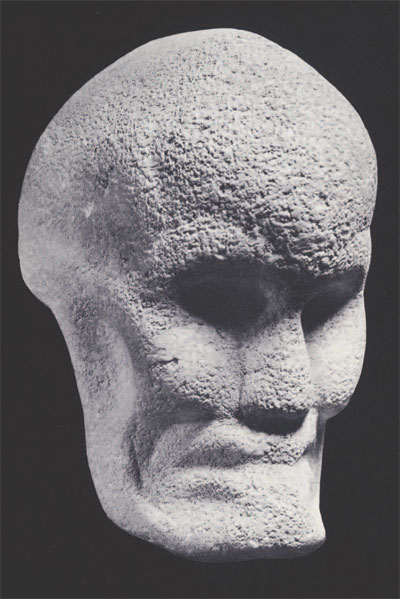
The New World archaeological collections of the University Museum are comprehensive, often superlative. But we are aware of certain shortcomings. One of these is a good synoptic display collection from the central portion of the Mexican State of Veracruz, on the Gulf Coast. In a recent gift by Major General Littleton W. T. Walter, a very fine human head of stone was received. Carved in the round and of a compact form of limestone, one outstanding feature of this excellent sculpture is the large notched area behind the head. This is probably sufficient to assign the piece to central Veracruz, where this feature constitutes a characteristic of a body of sculpture comprising “thin stone heads.” The latter form one part of a complex of specialized sculpture that flourished in Classic times, that is, during the latter part of the first millennium A.D. However, this recent acquisition far exceeds in width the general range of width-height proportions of known “thin stone heads.” Its actual measurements, in inches, are: height 6 3/4; width 4 1/4; thickness 4 1/2.
The blank hollowness of the eyes and the gentle front-rear crest of the head are further features associated with Veracruz sculpture of this general type. As to the deep notch at the back, good reasons exist for seeing this as a means for securing the head to a belt worn on ceremonial occasions.
The simplicity of this piece is outstanding. Conformation in front view may suggest death. The sunken mouth area and cheeks and the already noted vacant eyes add to this suggestion. Yet, in Pre-Columbian Mesoamerica, death was unequivocably depicted as a skull. Here, however, the nose is fairly pronounced on a face that we might more reasonably conclude to have been intended as emaciated. This lead carries us to the possibility that the ancient and widespread “old god” is portrayed. In Mexico, this deity was the god of fire. In the Maya area, an aged, near toothless god is shown emerging from the conch shell and serving as the god of number 5. Oddly, in both areas this emaciated personage is often shown with a beard. Our sculptured head is quite beardless. Perhaps on that score alone the cautious cataloguer should write “Identity unknown.”
